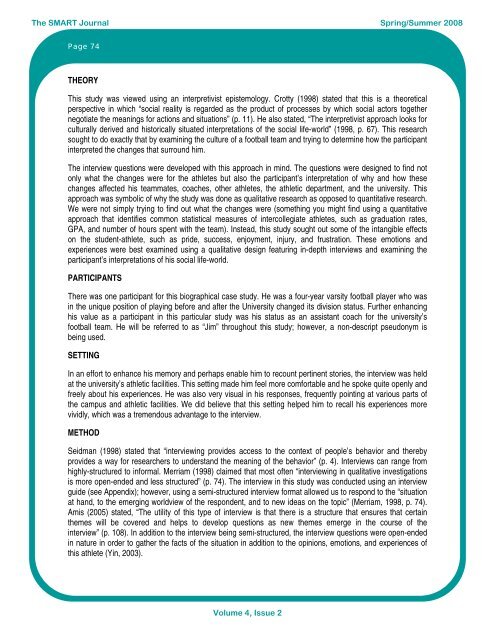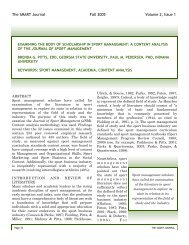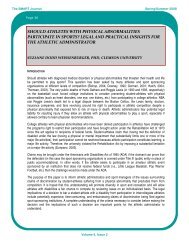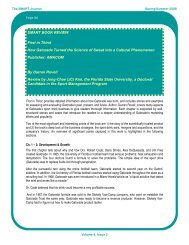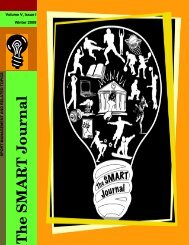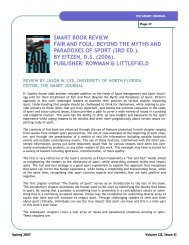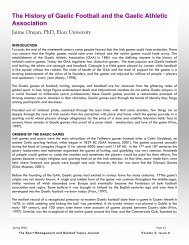Spring/Summer 2008 Volume 4, Issue 2 - The SMART Journal
Spring/Summer 2008 Volume 4, Issue 2 - The SMART Journal
Spring/Summer 2008 Volume 4, Issue 2 - The SMART Journal
Create successful ePaper yourself
Turn your PDF publications into a flip-book with our unique Google optimized e-Paper software.
<strong>The</strong> <strong>SMART</strong> <strong>Journal</strong> <strong>Spring</strong>/<strong>Summer</strong> <strong>2008</strong><br />
Page 74<br />
THEORY<br />
This study was viewed using an interpretivist epistemology. Crotty (1998) stated that this is a theoretical<br />
perspective in which “social reality is regarded as the product of processes by which social actors together<br />
negotiate the meanings for actions and situations” (p. 11). He also stated, “<strong>The</strong> interpretivist approach looks for<br />
culturally derived and historically situated interpretations of the social life-world” (1998, p. 67). This research<br />
sought to do exactly that by examining the culture of a football team and trying to determine how the participant<br />
interpreted the changes that surround him.<br />
<strong>The</strong> interview questions were developed with this approach in mind. <strong>The</strong> questions were designed to find not<br />
only what the changes were for the athletes but also the participant’s interpretation of why and how these<br />
changes affected his teammates, coaches, other athletes, the athletic department, and the university. This<br />
approach was symbolic of why the study was done as qualitative research as opposed to quantitative research.<br />
We were not simply trying to find out what the changes were (something you might find using a quantitative<br />
approach that identifies common statistical measures of intercollegiate athletes, such as graduation rates,<br />
GPA, and number of hours spent with the team). Instead, this study sought out some of the intangible effects<br />
on the student-athlete, such as pride, success, enjoyment, injury, and frustration. <strong>The</strong>se emotions and<br />
experiences were best examined using a qualitative design featuring in-depth interviews and examining the<br />
participant’s interpretations of his social life-world.<br />
PARTICIPANTS<br />
<strong>The</strong>re was one participant for this biographical case study. He was a four-year varsity football player who was<br />
in the unique position of playing before and after the University changed its division status. Further enhancing<br />
his value as a participant in this particular study was his status as an assistant coach for the university’s<br />
football team. He will be referred to as “Jim” throughout this study; however, a non-descript pseudonym is<br />
being used.<br />
SETTING<br />
In an effort to enhance his memory and perhaps enable him to recount pertinent stories, the interview was held<br />
at the university’s athletic facilities. This setting made him feel more comfortable and he spoke quite openly and<br />
freely about his experiences. He was also very visual in his responses, frequently pointing at various parts of<br />
the campus and athletic facilities. We did believe that this setting helped him to recall his experiences more<br />
vividly, which was a tremendous advantage to the interview.<br />
METHOD<br />
Seidman (1998) stated that “interviewing provides access to the context of people’s behavior and thereby<br />
provides a way for researchers to understand the meaning of the behavior” (p. 4). Interviews can range from<br />
highly-structured to informal. Merriam (1998) claimed that most often “interviewing in qualitative investigations<br />
is more open-ended and less structured” (p. 74). <strong>The</strong> interview in this study was conducted using an interview<br />
guide (see Appendix); however, using a semi-structured interview format allowed us to respond to the “situation<br />
at hand, to the emerging worldview of the respondent, and to new ideas on the topic” (Merriam, 1998, p. 74).<br />
Amis (2005) stated, “<strong>The</strong> utility of this type of interview is that there is a structure that ensures that certain<br />
themes will be covered and helps to develop questions as new themes emerge in the course of the<br />
interview” (p. 108). In addition to the interview being semi-structured, the interview questions were open-ended<br />
in nature in order to gather the facts of the situation in addition to the opinions, emotions, and experiences of<br />
this athlete (Yin, 2003).<br />
<strong>Volume</strong> 4, <strong>Issue</strong> 2


